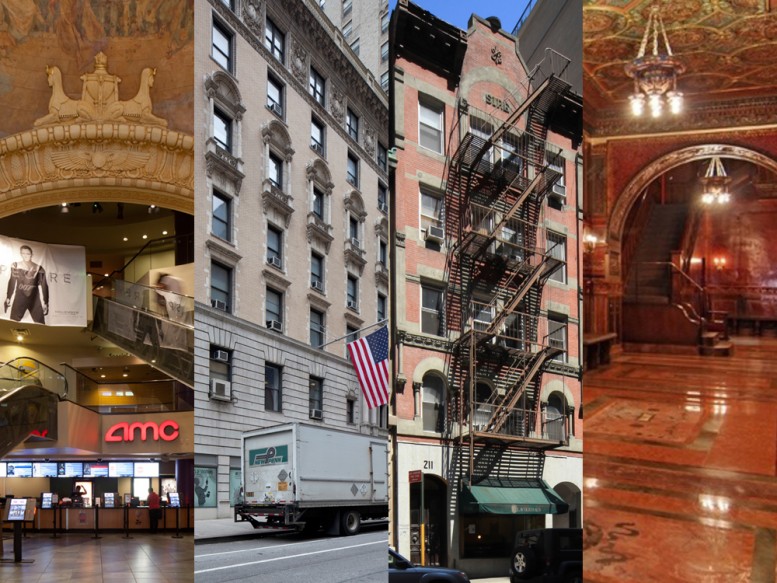Last Thursday, the Landmarks Preservation Commission held another public hearing in the process of dealing with its 95-item backlog. It was the first to deal with properties in Manhattan. In addition to hearing testimony about the IRT Powerhouse, Bergdorf Goodman’s headquarters, Union Square Park, and others, the commissioners heard about seven theaters on 42nd Street, a five-story building, a former hotel, and an apartment building lobby.
The theaters under consideration for designation are the Empire Theater (interior and exterior) at 236-242 West 42nd Street, the Liberty Theater (interior and exterior) at 234 West 42nd Street, the Lyric Theater (interior and exterior) at 213 West 42nd Street, the New Apollo Theater (interior) at 215-223 West 42nd Street, the Selwyn Theater (interior and exterior) at 229-231 West 42nd Street, the Times Square Theater (interior and exterior) at 215-223 West 42nd Street, and the Victory Theater (interior and exterior) at 207 West 42nd Street.
The Apollo and Lyric were combined into the current Lyric. The Empire (now an AMC) used to sit 168 feet east of its current location. The Victory is now operated as the New Victory Theater. All of them are part of the New 42nd Street partnership founded in 1990 to redevelop the street.
The partnership has a 99-year-lease on the properties and that includes maintaining and protecting them (though the Times Square Theater still needs much work). That was the basis for several people rising to oppose designation. Not only was there Cora Cahan, president of New 42nd Street. There was Layla Law-Gisiko of Community Board 5 and Andrea Goldman of the New York Landmarks Conservancy.
Rising to support designation was Leo Blackman of the Historic Districts Council (HDC), who praised the work done on them over the past 25 years, but said, “They are all worthy of Landmark designation, despite the de-construction of some elements.” The Victorian Society also supported designation, though of only the Empire, Liberty, Lyric, and Victory theaters.
Also considered was the former Hotel Renaissance at 4 West 43rd Street (just off Fifth Avenue). It was built as the hotel in 1894, but was taken over by the Columbia Club in 1917. In 1973, it was purchased by the Unification Church (the church of the late Rev. Sun Myung Moon), which still worships there today. Hearings were last held in May, October, and November of 2000.
Building owners often oppose designation of their structures, but that is especially true when it comes to churches, as was the case here. The president of the congregation, a congregant, and even architectural historian Andrew Alpern rose to speak against designation. CB5’s Law-Gisiko rose to support designation, as did HDC’s Barbara Zay, and a representative of the Victorian Society.
The Sire Building, at 211 West 58th Street (a bit west of Seventh Avenue), is a five-story-tall structure that dates back to 1885. It was built for owner Benjamin Sire and designed by William Graul in the High Victorian style. A hearing was last held on June 23, 2009.
There was no opposition voiced. Community Board 5 supports it. So does HDC. “This structure is a relic, and deserves to be preserved as one example of early residential development, when 58th Street was of a more human scale,” Zay said.
Rounding out our coverage of the day is consideration of the lobby of the Osborne apartments at 205 West 57th Street. The building itself, completed in 1885, was designated an individual landmark in 1991, but this would make it an interior landmark as well.
The LPC’s 1980 staff statement describes the interior as “sumptuous” with “ornate mosaics, marble, leaded glass, gold-leafed ornament, coffered ceilings, and murals” and attributes the design to John LaFarge (who worked on, among other things, the disused City Hall subway station).
Despite all of that, there is actually a fair amount of opposition to designation. One reason given is that interior landmarks are required to be publicly accessible and since the Osborne is a private residential building, it technically isn’t (though you could probably walk in there right now). Community Board 5 and the New York Landmarks Conservancy both opposed it, though the Victorian Society backed it.
From this point, the commission will hold public meetings, at which time it will consider either prioritizing designation for some items by December 2016, removing items from the calendar by voting not to designate, or removing items from the calendar by issuing a no action letter.
Subscribe to YIMBY’s daily e-mail
Follow YIMBYgram for real-time photo updates
Like YIMBY on Facebook
Follow YIMBY’s Twitter for the latest in YIMBYnews





